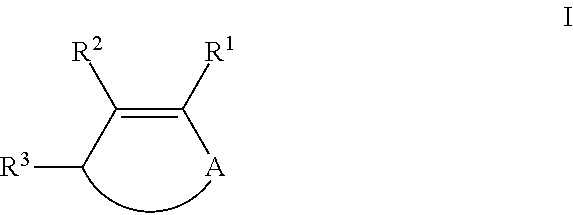Process for preparing ketones, in particular macrocyclic ketones
a macrocyclic ketones and process technology, applied in the field of macrocyclic ketones, can solve problems such as unsatisfactory known processes
- Summary
- Abstract
- Description
- Claims
- Application Information
AI Technical Summary
Benefits of technology
Problems solved by technology
Method used
Image
Examples
example 1
Synthesis of 14-methylbicyclo[10.3.0]pentadecene[1(12)]
Step a): Alkylation of Cyclododecanone Using Methallyl Chloride
[0091]1458.4 g of cyclododecanone are dissolved in 1440 g of toluene and admixed with 30.4 g of tetrabutylammonium iodide. 1920 g of sodium hydroxide solution (50% strength) are added and the two-phase mixture is heated to 90° C. with vigorous stirring. 1087.2 g of methallyl chloride are then added dropwise over a period of 1 hour. After the addition is complete, the mixture is stirred at 90° C. for 5 h. It is allowed to cool to 60° C. and 1500 ml of water are added. The phases are separated and the organic phase is washed firstly with 2000 ml of water, then with 2000 ml of 10% strength H2SO4 and then with 2000 ml of 10% strength sodium hydroxide solution.
[0092]All low boilers are distilled off, and the product is subsequently purified by rectification. 2-(2-Methallyl)cyclododecanone goes over at 10 mbar, 164-165° C. A yield of 73% is obtained.
Step b): Gas-Phase Cycl...
example 2
Oxidation of (Ia) by Means of N2O
[0095]The reaction was carried out in a tube reactor having a diameter of 1.7 mm and a total volume of 210 ml. The tube was provided with a double wall through which a heat transfer oil whose temperature was regulated by means of an external thermostat to 280° C. was circulated in order to thermostat the reactor. The reaction pressure was set to 270 bar by means of a pressure-regulating valve at the reactor output. The starting materials were metered continuously into the reactor by means of two metering pumps. Liquid N2O (Linde, 2.5, 25 g / h) was introduced by means of the first pump and the olefin (Ia) (150 g / h) was introduced by means of the second pump. The experiment ran for a total of 4 hours. The reactor discharge was, after depressurization, cooled, collected and analyzed by GC. The conversion of la was 10.3%. The selectivity to the desired product (3-methylcyclopentadec-5-enone and 3-methylcyclopentadec-4-enone, in each case as a mixture of t...
example 3
Hydrogenation of the Oxidation Discharge
[0096]1380 g of crude discharge from Example 2 (comprising 4.7% of muscenone, 74.2% of 14-methylbicyclo[10.3.0]pentadecene[1(12)], 4.3% of isomers of 14-methylbicyclo[10.3.0]pentadecene[1(12)] and 1.6% of diketones) and 11.0 g of Pd / C catalyst (˜5% of Pd, ˜50% of moisture (water) are placed in a 2.51 autoclave provided with a three-stage inclined-blade stirrer. The autoclave is flushed with H2 and the reaction mixture is subsequently heated to 100° C. After this temperature has been reached, the autoclave is pressurized with 10 bar of H2 and the reaction is started. The H2 pressure is kept constant at 10 bar during the course of the reaction. After the reaction is complete, the autoclave is cooled, depressurized and the catalyst is filtered off. After a reaction time of 12 h, the muscenone conversion is 94.3% and the selectivity to muscone is 94.1%. The crude product obtained in this way is composed of 4.8% of muscone, 73.9% of 14-methylbicycl...
PUM
| Property | Measurement | Unit |
|---|---|---|
| mol % | aaaaa | aaaaa |
| mol % | aaaaa | aaaaa |
| temperatures | aaaaa | aaaaa |
Abstract
Description
Claims
Application Information
 Login to View More
Login to View More - R&D
- Intellectual Property
- Life Sciences
- Materials
- Tech Scout
- Unparalleled Data Quality
- Higher Quality Content
- 60% Fewer Hallucinations
Browse by: Latest US Patents, China's latest patents, Technical Efficacy Thesaurus, Application Domain, Technology Topic, Popular Technical Reports.
© 2025 PatSnap. All rights reserved.Legal|Privacy policy|Modern Slavery Act Transparency Statement|Sitemap|About US| Contact US: help@patsnap.com



